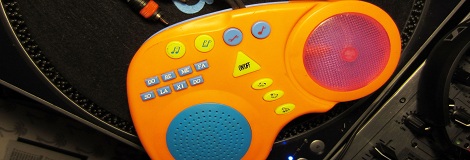Finally an Arduino shield that does nothing

The folks at Evil Mad Scientist labs have finally created the Googly Eye Shield for Arduinos. With it’s pass-through .100 headers, it adds googly eyes to your Arduino projects. Of course, instead of in addition to the googly eyes you could add a breadboard, making it somewhat useful. A million fake internet points goes to the first person to implement Xeyes on this thing.
Phat beats from kids toys

[Ville] couldn’t afford an Akai MPC for laying down some beats. Wanting a real tactile interface, he hacked this kid’s toy. It’s just an RCA cable attached to the tiny chip inside the toy. The new line out goes to his mixers where he does some pretty impressive stuff.
Mona Lisa is Vigo the Carpathian

What did we just say about real-life Xeyes? [Geert] just made a print of the Mona Lisa follow you around the room with her eyes (Dutch, translation). The build is a pair of servos and a DIY motion capture app running on a laptop. Now we need to find a print of Vigo…
Quantifying heat sink efficiencies

[Mike] is an experimenter at heart. He was wondering about the efficiency of small, clip-on heat sinks versus the ones we use to defrost frozen food. The results are exactly as you would expect, but he did find something interesting – his experimental technique didn’t find much of a difference between thermal paste/grease/pads and no thermally conductive material.
Mini-fig sized R/C LEGO car

The guys at Brickmodder.net took a car from a LEGO set and made it remote control. The drive train and steering both use servos controlled by the smallest 3-channel receiver they could find.















For low power densities, the thermal paste doesn’t make any noticeable difference as long as both surfaces actually touch for the most part.
It’s common knowledge among any who has overclocked a computer. Unless you’re really ripping it, the most expensive silver paste is about as effective as strawberry jam.
However, I would like to question the guy’s measurements because he was measuring the temperature at the back of the casing with an IR thermometer that measures over an area. The C/W rating of the component is to the front of the casing, or to the metal strip – not to the plastic, so his junction temperature estimates are way off.
What he should be measuring is the temperature of the metal heat spreader right in between at the spot where the actual chip is.
He is missing the termal resistance of the transistor towards the heatsink (increasing the steady state temperature of the transistor).
He is also missing the termal resistance of the transistor towards the surrounding air (dereasing the steady state temperature of the transistor).
The first effect is more important for large heatsinks, the second is more important for small heatsinks, this is why the small ones overperform and the large ones underperform in this experiment.
Thermal paste is not relevant in this experiment as large amounts of the heat are dissipated by the transistor directly. Turning the large heatsink so that the transistor is at the underside would show this.
Thermal paste is also not relevant when mating two reasonably smooth surfaces. The paste is designed to fill the voids between the mating surfaces so if the heatsink is scratched or warped it would make a huge difference.
Thermal paste is a horrible thermal conductor really, far worse than metal-metal contact, but far better than a void of air. Applying it liberally is exactly what you should NOT do, and there are plenty of cases of overheating / failing consumer electronics (even one Apple laptop) due to the over application of thermal grease.
He could have done this correctly had he read this: http://robots.freehostia.com/Heatsinks/Heatsinks.html
Plus, he could have done all he did quicker if he had known the C/W for each heatsink and datasheets for the components.
Arduino googly eyes! All our hate for the Arduino has suddenly been solved.
He’s wrong with the thermal paste stuff. “I’ve always been told to be liberal with the paste”( or something).
Well that’s not true you need less paste than you’d imagine I barely use any on my lapped waterblock and cpu.
Then again lapped surfaces aren’t that common. Even if a sink surface is repetitively sooth, the mating surface of the device is by comparison is not.
Wile Mike’s account of his experiment was interesting to read, and a thank you to him for posting it. However one EEVblog video on the topic could provide more useful.
http://youtu.be/8ruFVmxf0zs